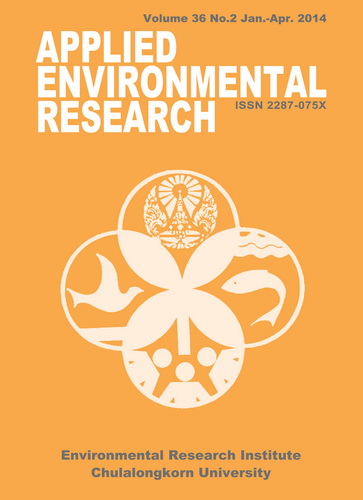Exposure to BTEX and Assessment of the Potential Risk among Pregnant Residents Living in the Vicinity of a Petro-chemical Industrial Estate
Main Article Content
Abstract
This research was conducted to estimate exposure and risk of exposure to BTEX (benzene, toluene, ethylbenzene and xylene) by a cross-sectional studying among pregnant women who lived in the vicinity of a petro-chemical industrial estate area. Personal exposure was monitored by environmental and biological sampling. Other relevant data were gathered by a structured questionnaire for analysis. The relationship between BTEX exposure and potential risk factors was determined by multiple linear regression. Average BTEX exposure levels were 18.89, 29.40, 10.26, and 17.85 µg m-3, respectively, which were significantly higher than the control group. Urinary metabolite levels of muconic acid (t, t-MA), hippuric acid (HA), mandelic acid (MA), and methyl-hippuric acid (mHA) were significantly higher in pregnant residents living in the vicinity of the petro-chemical industrial estate area. The correlation between women’s individual exposure to BTEX and their urinary metabolites showed significantly difference between groups. Risks of benzene and ethylbenzene exposure for these pregnant subjects were approximately 4.37x10-7 and 1.92x10-8 lower than the acceptable limits of United States Environmental Protection Agency (US.EPA.) guidelines (10-6). The hazard index (HI) of these pregnant subjects a lifetime rate was 0.555 which was below the reference level (HI < 1). Multiple linear regression analysis found that t, t-MA, HA, MA, and mHA in the urine of all models were significantly (p < 0.05) and positively related with BTEX in ambient air. The study showed that there was a low cancer risk for pregnant women in the petro-chemical industrial estate zone. However, when compared with the control area, a statistically significant difference was found in the relationship between BTEX content in ambient air and metabolites in the urine of pregnant women. The implication is that the responsible government agencies should implement health surveillance continuously.
Article Details

This work is licensed under a Creative Commons Attribution-NonCommercial 4.0 International License.
Published articles are under the copyright of the Applied Environmental Research effective when the article is accepted for publication thus granting Applied Environmental Research all rights for the work so that both parties may be protected from the consequences of unauthorized use. Partially or totally publication of an article elsewhere is possible only after the consent from the editors.

